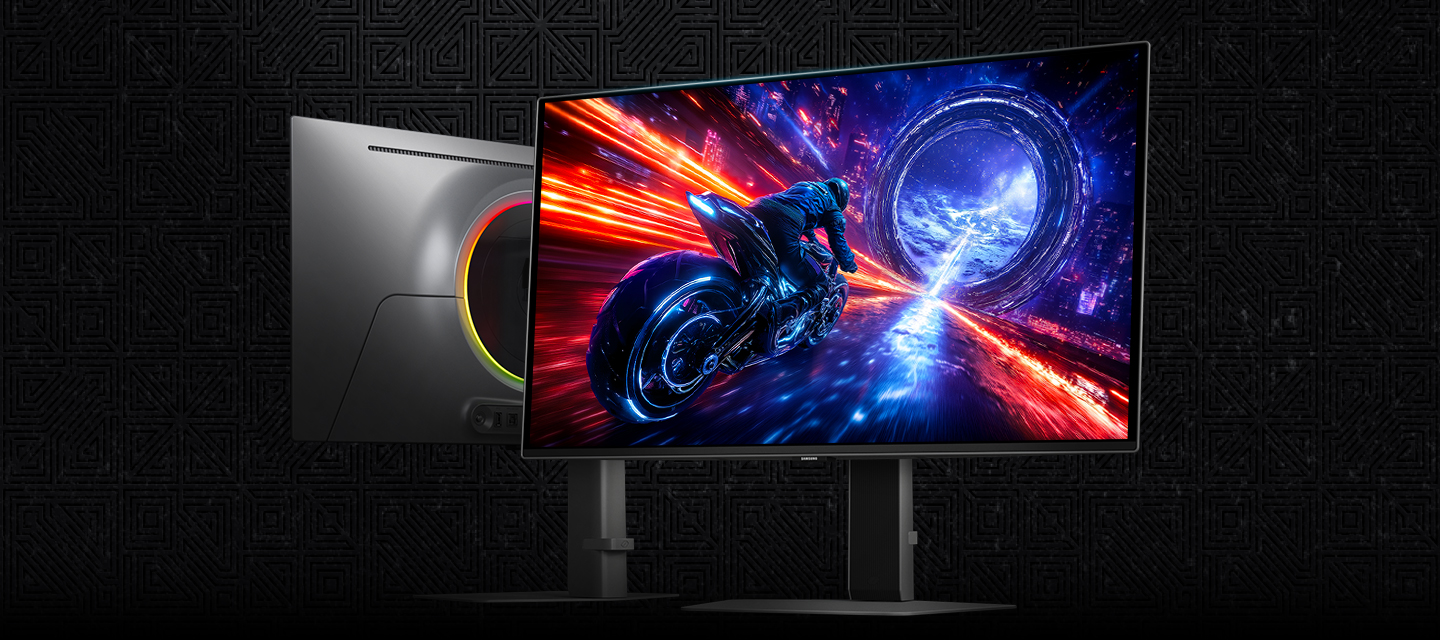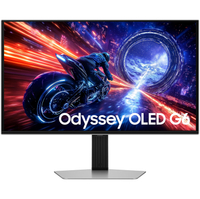Samsung launches the world's first 500Hz OLED gaming monitor for $1,300, with its burn-in-fighting heat pipes in tow
Everybody hertz, sometimes

Samsung has just announced the launch of its brand new Odyssey OLED G6, the world's first 500Hz gaming monitor.
First unveiled at CES 2025, the Samsung Odyssey OLED G6 joins the company's already-stacked roster of gaming panels and gives even the Asus ROG Swift PG27AQDP a run for its money as the best gaming monitor on the market when it comes to refresh rate.
As announced by Samsung, the Odyssey OLED G6 is launching in four countries, Singapore, Thailand, Vietnam, and Malaysia, with a phased rollout to additional global markets "later this year."
Of course, the headline feature is the 500Hz refresh rate, but there's also a 0.03ms response time (GTG) and QHD resolution, VESA Display HDR True Black 500 HDR, and HDR10+ Gaming.
The flat 27-inch panel comes with DisplayPort 1.4, HDMI 2.1, and USB ports aplenty. You'll also find Samsung's Glare Free technology, which it says makes your screen 54% less glossy than conventional film.
Currently available in Singapore, Thailand, Vietnam and Malaysia, the Samsung Odyssey OLED G6 G60SF QHD can be bought from Samsung for around $1,300 US, althou there's currently a $200 saving in local currency according to its website.
Users wary of OLED burn-in will be delighted to learn that the G6 features Samsung's Pulsating Heat Pipe technology to reduce panel heat, as well as a Thermal Modulation System to automatically control brightness, and logo and taskbar detection. Samsung's burn-in warranty contains the usual boilerplate mentions of normal usage being covered within warranty, but no commercial, abuse, or misuse.
Peak brightness is rated for 1,000 nits, and you'll also find Samsung's Glare Free Technology, a height-adjustable stand, tilt, swivel, and pivot adjustments. There's also support for NVIDIA G-Sync
Stay On the Cutting Edge: Get the Tom's Hardware Newsletter
Get Tom's Hardware's best news and in-depth reviews, straight to your inbox.
The monitor is available in one color, silver, with a metal design rather than a plastic backing. As noted, Samsung hasn't shared any further details about a global rollout, so there's no official US pricing or timeframe at this point.
Follow Tom's Hardware on Google News to get our up-to-date news, analysis, and reviews in your feeds. Make sure to click the Follow button.

Stephen is Tom's Hardware's News Editor with almost a decade of industry experience covering technology, having worked at TechRadar, iMore, and even Apple over the years. He has covered the world of consumer tech from nearly every angle, including supply chain rumors, patents, and litigation, and more. When he's not at work, he loves reading about history and playing video games.
-
sygreenblum Three Questions.Reply
Can DP 1.4 even support 500Hz? If so at what resolution? Also, can the human eye actually see any improvement over say 400Hz. -
bill001g I see from the previous comments a lot of people on this forum see the marketing lies. Unfortunately the dumb guy with too much money who will buy this will stare at his frame count number on the screen and celebrate his stupid purchase.Reply
I forget the calculations but 1440 at 500hz is somewhere in the 50gbps. Only dp 2.1 can think to do it. Will have to use HDMI 2.1 and use DSC
So now you have even more fake frames. The video card will likely have to use DLSS with frame gen in games. But even on a simple windows desktop using DSC and compressing the data to get higher frame rates is just another variation of the fake frames. -
HyperMatrix Reply
Yes. There's a different in smoothness/clarity/motion tracking for me at 240Hz with and without using Motion Blur. While you may say "400Hz is good enough" I think realistically our eyes are able to track more easily at even higher refresh rates. While this won't matter in a lot of games, it definitely will in fast paced FPS games with lots of camera panning. Remember the perception of smoothness isn't just based on refresh rate, but the physical distance at which an object is moving on the screen. The faster the panning/object distance moved, the higher of a refresh rate you need to "fill in all the gaps."sygreenblum said:Three Questions.
Can DP 1.4 even support 500Hz? If so at what resolution? Also, can the human eye actually see any improvement over say 400Hz.
I think we'll see benefits in those games all the way up to 1000Hz. Is it worthwhile benefits? For most people? Considering the GPU power required? Arguable. -
BFG-9000 It was pretty common for 240Hz TVs to only achieve it with motion interpolation, aka fake frames generated within the TV itself to produce the "soap opera effect," given that no input at anywhere near that frequency was allowed.Reply
But this is a pricey "gaming monitor" where presumably everyone would disable any kind of DSP to reduce latency, so failing to license a faster DisplayPort + add the hardware to use it is puzzling. -
HyperMatrix ReplyBFG-9000 said:It was pretty common for 240Hz TVs to only achieve it with motion interpolation, aka fake frames generated within the TV itself to produce the "soap opera effect," given that no input at anywhere near that frequency was allowed.
But this is a pricey "gaming monitor" where presumably everyone would disable any kind of DSP to reduce latency, so failing to license a faster DisplayPort + add the hardware to use it is puzzling.
There is no input lag from using DSC, and DSC is visually lossless. And if you have an RTX 5000 series card, you don't run into the issues with limitations related to Nvidia's scaling technology when using DSC. So there is no benefit to using DP2.1 as all it does is increase cost, and limit you to a 6 foot cable currently. -
BFG-9000 Reply
Yes, but why did you quote me when I did not mention DSC at all? DSC is a lossy compression algorithm while motion interpolation makes fake interpolated frames just like the MFG feature of DLSS 4, only a TV will have way less processing power than a GPU hence the lag from enabling it.HyperMatrix said:There is no input lag from using DSC, and DSC is visually lossless. And if you have an RTX 5000 series card, you don't run into the issues with limitations related to Nvidia's scaling technology when using DSC. So there is no benefit to using DP2.1 as all it does is increase cost, and limit you to a 6 foot cable currently.
Bill, DSC 1.2 over HDMI 2.1 may have double the bandwidth of DSC 1.2 over DisplayPort 1.4 but either should be adequate to drive 500Hz at 1440p if the monitor can decompress DSC. And yes, I'd like to see a GPU that could maintain that without MFG. -
HyperMatrix Reply
I thought you were mistaking DSC for some form of interpolation that was allowing 500Hz because I didn’t see anything in the article that indicated an issue with DSP input latency due to the scalar hardware used.BFG-9000 said:Yes, but why did you quote me when I did not mention DSC at all? DSC is a lossy compression algorithm while motion interpolation makes fake interpolated frames just like the MFG feature of DLSS 4, only a TV will have way less processing power than a GPU hence the lag from enabling it.
You specifically mentioned people disabling the DSP on this monitor. Which again as far as I’m aware wasn’t mentioned. You then added that as a result of people wanting to disable DSP, they should have licensed DP2.1 port. Which again…would have nothing to do with the input latency concerns you’re referring to.
P.S. DSC is a visually lossless compression algorithm. -
JTWrenn Reply
People will argue about it forever but generally the gains get smaller and smaller. So 60 to 120 if you see let's say 50% gain in smoothness. 120 to 240 would be 25% gain and 240 to 480 12.5%. As far as what you can see...everyone is different so try them out and see what makes a difference.sygreenblum said:Three Questions.
Can DP 1.4 even support 500Hz? If so at what resolution? Also, can the human eye actually see any improvement over say 400Hz.
To get to that frame rate though, you are going to be playing in potato mode so I don't enjoy it.
I think people want a definite answer on this and there just isn't one because all our eyes are different and then their is your brain processing it. I have always found I see clarity more than others but the HZ doesn't bug me as much, but at the same time I see a lot of stutters. So for me I like 4k with a big graphics card and things tuned to keep it locked at 60 fps. Everyone is different so find what you like and go for it.
I would love to see a 120hz 4k oled with some real burn in resistance that isn't crazy priced rather than pushing higher and higher hz, but it's all buzz words.
